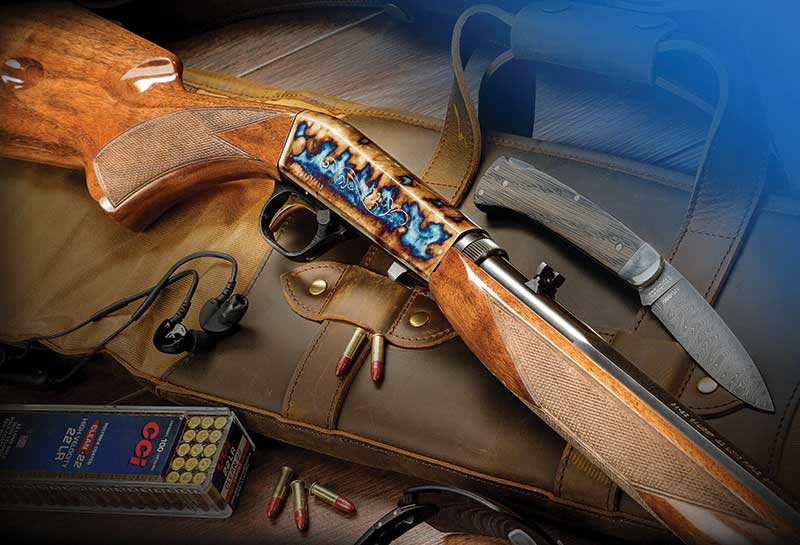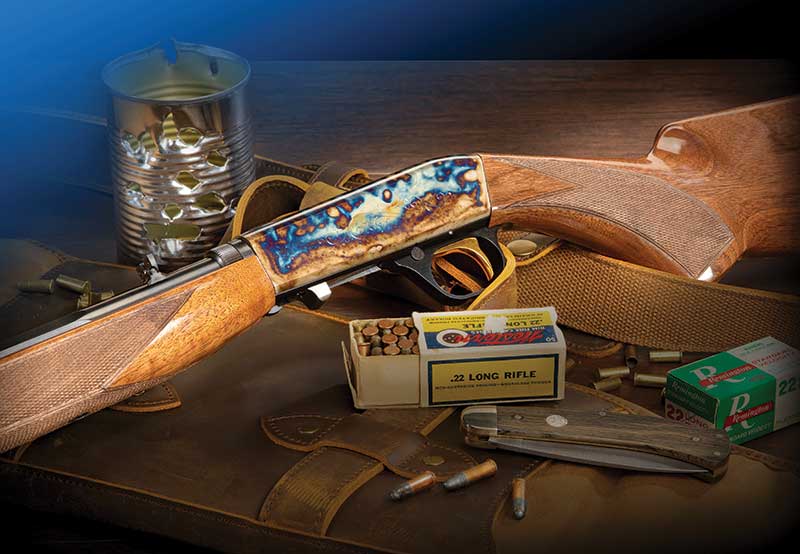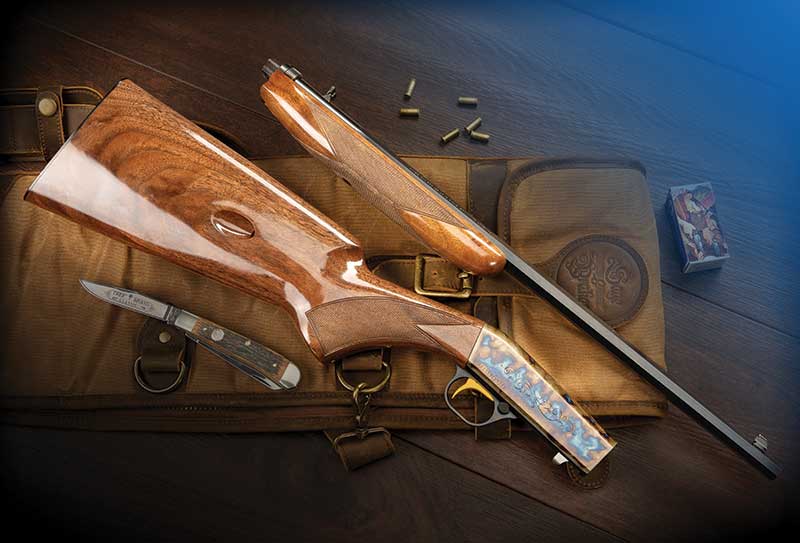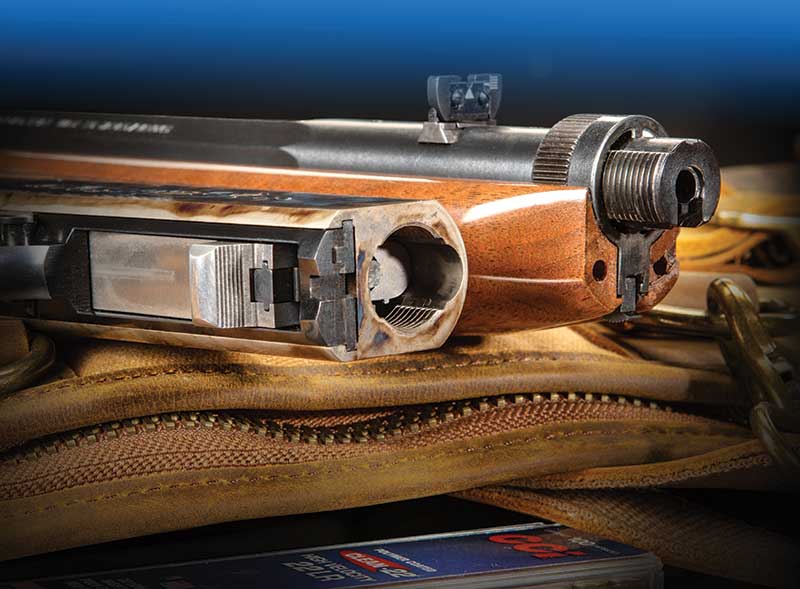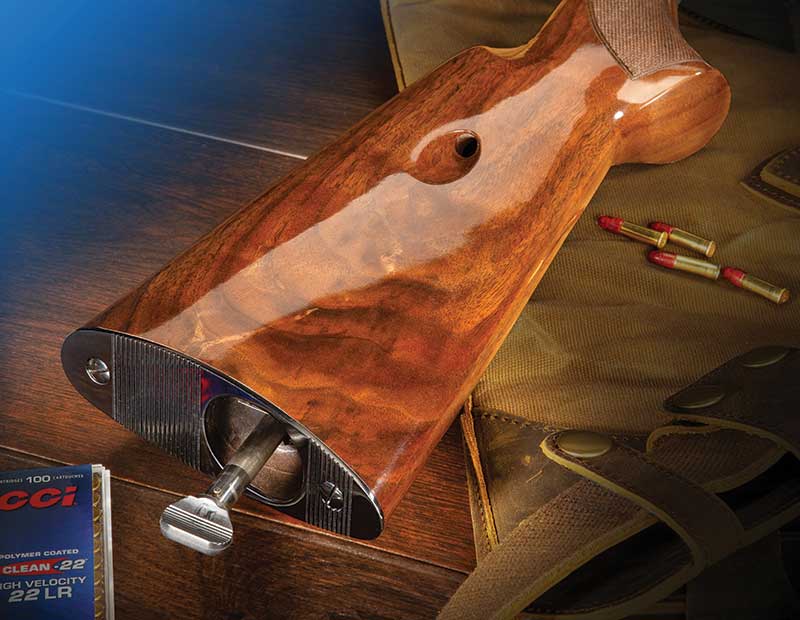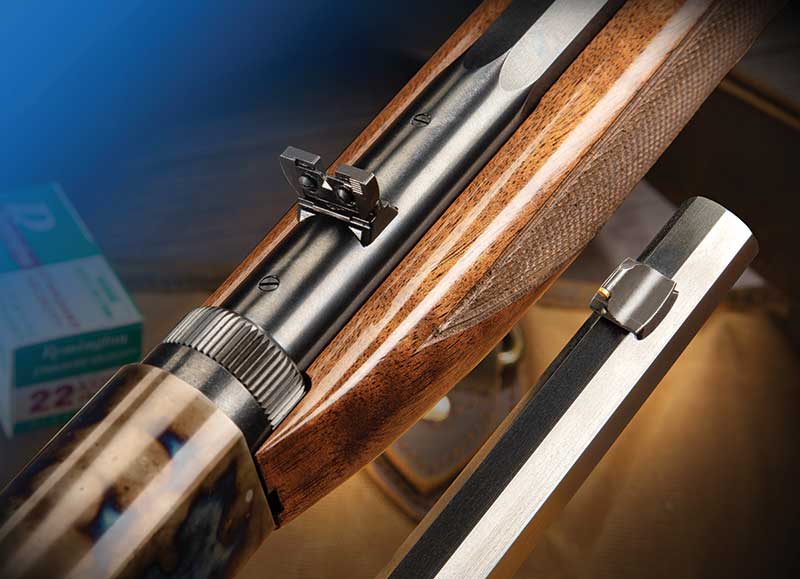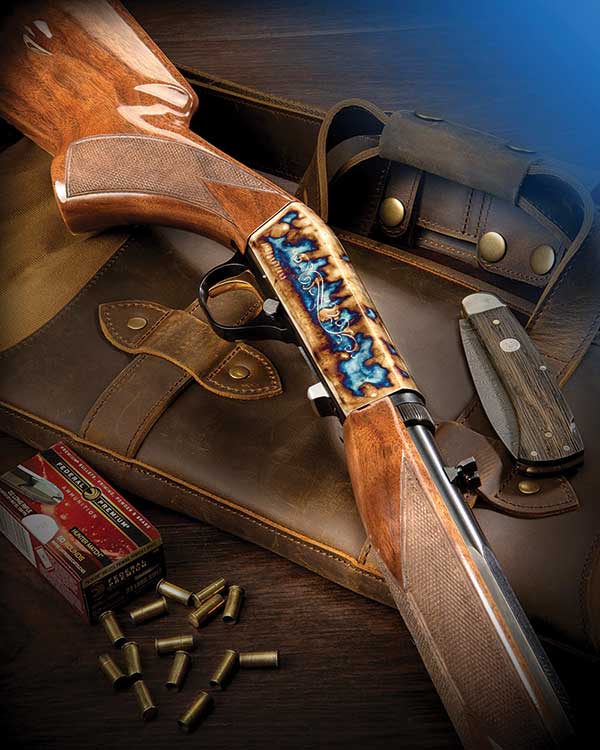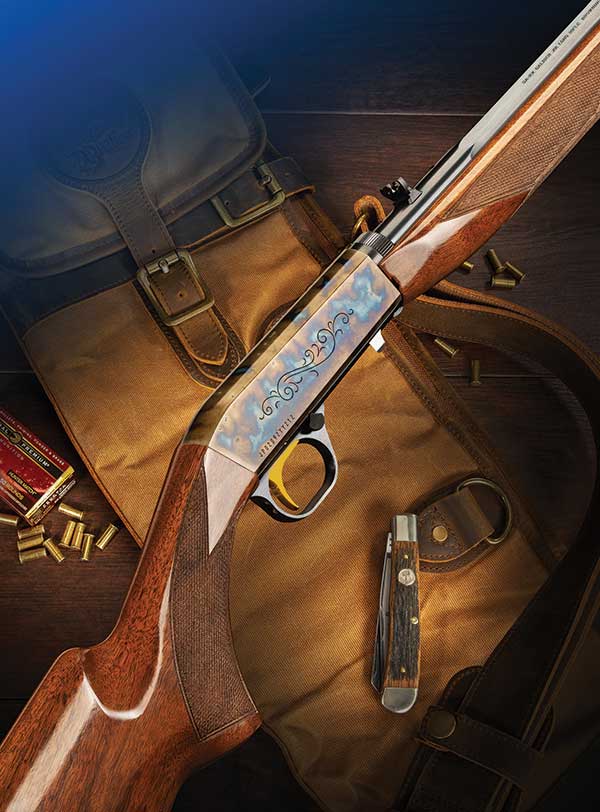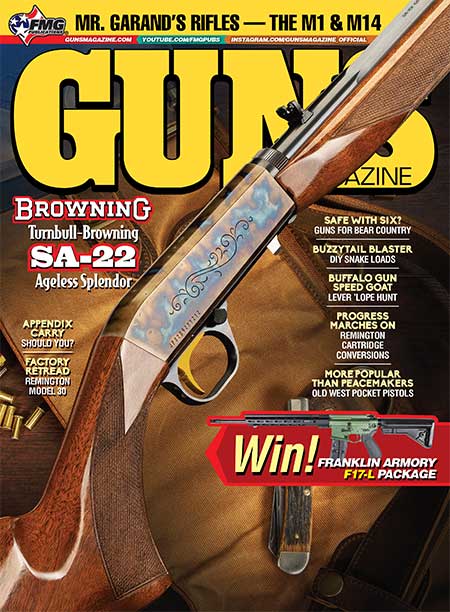Turnbull-Browning
Elegant Grade SA-22
Enriching 110 Years Of Service And Style!
When I was about 10 living in Australia, my dad used to take me hunting rabbits on local ranches (or “stations” as they were called). Rabbit populations were overflowing and a morning tally of 50 or more was common, all without making a dent in the population. On one trip my dad invited a friend from the American Embassy where he was assigned. At the station, as we got rifles out of cases, dad’s buddy pulled out a Browning SA-22 — the first I’d ever seen. I was used to my Remington 514 single-shot .22 and I confess this amazing new gun won my heart.
Later on in the day we paused for a bit of plinking and I got to shoot it quite a bit. At that moment I realized life was made up of more than single-shot .22s and bolt-action shotguns. In my early 20s I finally found an SA-22 I could afford and haven’t been without one since.
Beautiful Practicality
Our test gun here is a stunning modern Browning made in Japan by Miroku and is every bit of the quality as those put out in Belgium in the early days. Turnbull Restorations receives new SA-22s then hand engraves the receiver, adding a touch of class. The receiver is sent to the finish shop where it’s treated to their bone charcoal color case-hardening. The result is both eye-pleasing and practical, and in my opinion, looks right at home on this lovely little rifle.
All other metal work is stock Browning and I’d consider it very fine at every level, including the steel butt plate. Browning supplies upgraded wood on this Grade II model and it shows. The Grade II also features a 19 ⅜” barrel and standard Browning sights. With the Turnbull touches, the stock SA-22 is turned into an instant family heirloom and pushes pride of ownership through the roof.
I think Sarah Turnbull, owner of Turnbull Restoration summed it up best: “One of my favorite things about this rifle is how it brings generations together. We had a father and son in the other day, just driving past on a day off from school looking for something to do. They were enraptured by our showroom, but what really caught their eyes were these engraved SA-22 and BL-22 rifles. They knew guns, and had shot .22 rifles together for fun, but there was something about the combination of the hand-engraved, traditional finishes on a modern rifle that really grabbed their attention. This was something they could use together; this was something they could turn into a family heirloom and make memories with now, and with the next generation.”
I don’t think you get that with a skateboard — or a video game.
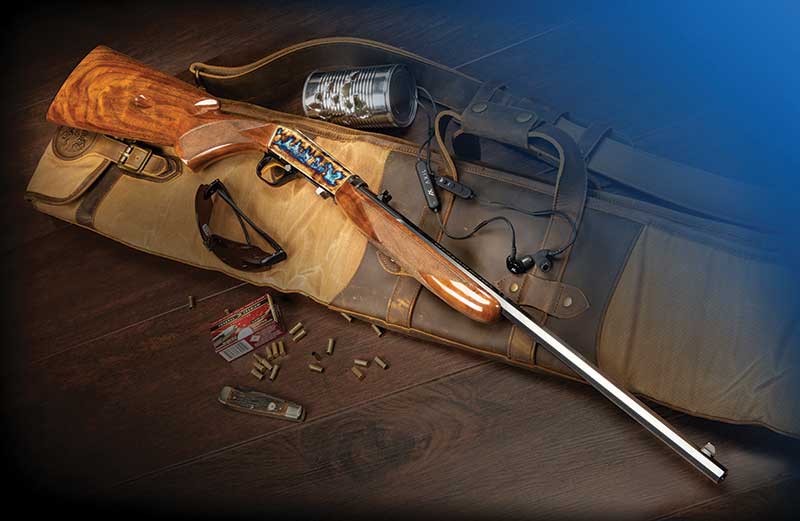
Browning SA-22 Gear List
Rifle Case: Sage & Braker Unscoped Rifle Case
New Ammo: Federal 40-grain Hunter Match and CCI Clean 22
Old Ammo: Winchester Boy Scouts of America, Remington Std Velocity, Western 40-grain,
Ear Pro: Axil GS Extreme 2.0
Eye Pro: Wiley X WX Vapor,
Knives:Boker Traditional 20-20 Duo
The Saga
A bit of history is in order here. The legendary designer John Browning designed what was to become the SA-22 (Semi-Automatic 22) around 1914, just before his ground-breaking work on the machine guns of WWI. This was the world’s first semi-auto .22 and Browning licensed it to Fabrique Nationale in Liege, Belgium. FN produced it until 1974 when the modern Browning corporation changed to Miroku Co., in Japan. I’ve owned both makers’ guns and I honestly can’t tell any difference — both are of extremely high quality. Some models were also made in .22 Short, expanding on the .22 LR of the original. The Short version proved popular with young shooters and price-conscious adults since in the “old days,” .22 Short ammo was cheaper than LR.
From about 1919 to 1949, licensed copies called the Models 24 and 241 were also made by Remington. They were popular but didn’t show the same high caliber of workmanship the FN guns did. Nonetheless, thousands were put to hard use on farms and in the field in the hands of young and old shooters alike across the nation.
Amazingly, the SA-22 is still in production with no breaks since 1914. Over 500,000 have been produced and all show that same original quality Browning always demanded. Today, Browning offers four grades of the SA-22, from the entry-level Grade 1 at $800 to the “really fancy” Grade IV at $1,800 with gold game scenes on the receiver. Some models can be ordered with a handsome satin nickel (grayed) receiver but my favorite is the Grade II with the octagon barrel like our sample rifle. A stock Grade II is $1,129 while our Turnbull-enhanced Grade II SA-22 goes for $1,450.
Particulars
Keep in mind these are old-school guns of steel and walnut, showing much attention to detail. There are reasons the SA-22 — essentially unchanged from Browning’s original design — is still in production and still popular.
Remarkably for today’s world, the SA-22 is made of forged steel, straight-grained walnut and showcases actual hand-checkering. That checkering really stands out as it’s easy to forget what “real” checkering looks like in this age of pressed-in or machine checkering. To hold, shoot and admire the SA-22 is simply a delightful distraction.
A straight blow-back action, the barrel and receiver can be joined or taken-down in just a few seconds by pulling the latch on the underside back, disengaging a secondary locking latch and giving the barrel a quarter turn. The interrupted threads on the barrel shank allow this handy take down process to go smoothly. This also allows you to clean the barrel from the breech end — a truly handy feature.
When taken down, the butt and receiver measures 18″ while the barrel shows right at 19.5″. Browning offers a traditional, handsome, fitted hard case specifically for the SA-22 for about $350.
Shooting/Field Use
An SA-22 weighs only 5.5 lbs. When you pick one up and wrap your hands about the slender receiver, your feet begin to walk almost automatically. This rifle simply begs to be taken afield to participate in plinking events in the backyard, ding some .22 spinner targets and chase squirrels and rabbits.
This is old school from top to bottom. The sights are vintage, with the rear folding down and adjustable for elevation by moving the blade up or down. Windage is managed by gently tapping the rear left or right in the dovetail. The rear is a sort of typical “buckhorn” design with a bead post style up front. While the combo is fine for small game and field use, it isn’t as precise as a better design might be. But hey, this is a 10- to 50-yard small game and plinking rifle so just relax and enjoy it.
My test gun ran like the proverbial top, shooting everything I put into it. CCI Mini-Mags did what they do best — shoot reliably and accurately. I tried some “target” loads but found it really didn’t matter due to the sight situation. If I relaxed and shot smoothly, the 4.5-lb. trigger break allowed groups in the 1.5″ range at 50 yards. I know it will do better because my old scoped one could go a bit under an inch at 50 with the right ammo. But it’s not about doing that, is it?
Loading is easy too. Pull out the follower from the back of the stock, then drop ten .22 LR rounds into the angled hole on the side of the butt. Push the follower in and give it a half-turn to lock it. Pull the bolt latch on the underside to the rear chambering a round, then push the cross-bolt safety off at the front of the trigger guard. To unload, you can either operate the bolt latch on the underside ejecting loaded rounds, or pull the follower out, then dump the loaded rounds out of the buttstock. A few gentle taps help to coax them out. Either way, make sure you operate that latch a few times to make sure the chamber and magazine is clear, and eyeball the breech face to triple-check things.
The only interesting challenge to this rifle is the fact the hot empties eject right out of the bottom of the receiver. If you’re wearing a long-sleeved shirt, they do tend to find their way past your cuff and you might be surprised at just how hot a freshly fired .22 case is. Keep your cuff buttoned-up tightly.
Final Thoughts
Mike Nelson of Turnbull had this to say about rimfires — “We all know the bonding powers of our favorite rimfires. They connect us to memories of teaching our kids how to shoot, and to our own childhood memories running a .22 for the first time. They bring us back to chasing squirrels around with our friends, and to summertime hangouts taking turns taking down cans.
Just like with our restoration work over the past 30-plus years, being in the memory business with our factory-new lineup is a distinct honor as well. Making that kind of mark with our customers and their families is what it’s all about for us, and it’s what gets us excited about our work.”
I simply couldn’t have said it better, Mike. Turnbull offers an opportunity to join this celebration so don’t think too hard about it — just do it.
